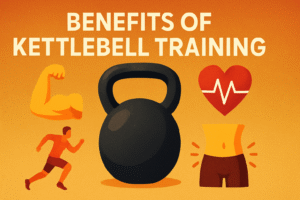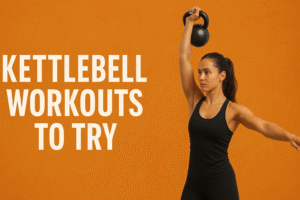Kettlebells have become one of the most versatile tools in modern fitness. With just one piece of equipment, you can build strength, torch calories, and improve mobility. But within kettlebell training, there are two dominant approaches: the hardstyle kettlebell method and the flow kettlebell program. Hardstyle Kettlebell vs Flow Kettlebell Program?
Both styles use the same tool, yet the training philosophy, movement quality, and outcomes differ significantly. Hardstyle focuses on discipline, power, and measurable strength gains. Flow training emphasizes creativity, continuous movement, and mobility.
You’ll discover how both training methods work, their benefits, essential exercises, sample workouts, and a beginner-friendly 4-week plan. By the end, you’ll know exactly how to choose (or combine) the right style for your goals.
What Is Kettlebell Training?
A kettlebell is a round weight with a handle, often compared to a cannonball with a grip. At first glance, it looks simple, but it’s one of the most powerful training tools available. Unlike dumbbells or barbells, a kettlebell’s weight sits off-center, which means your body has to stabilize harder during every swing, press, or squat.
That unique design makes kettlebells perfect for full-body workouts, where strength, conditioning, and mobility blend seamlessly.
Two popular methods dominate kettlebell culture today: the hardstyle kettlebell system and the flow kettlebell program. Hardstyle emphasizes explosive power and strict form, while flows focus on creative, continuous sequences. Both can deliver fat loss, muscle development, and improved endurance—but they approach training in very different ways.
Whether you train at home or in the gym, kettlebells offer a scalable, efficient solution for building strength and fitness.
Hardstyle Kettlebell Training Explained
The hardstyle kettlebell method is rooted in martial arts and powerlifting. It was popularized in the West by Pavel Tsatsouline and the StrongFirst community. Hardstyle is built on the principle of creating maximum tension when lifting, then releasing it with precision.
The approach emphasizes short, powerful bursts of work. For example, the kettlebell swing—a hip-hinge movement—generates explosive force from the glutes and hamstrings. Other essentials include the Turkish get-up (TGU), clean and press, and goblet squat.
The benefits of hardstyle training are clear:
Strength and power: It develops the force you can apply in sports, lifting, and daily activities.
Conditioning: Workouts are intense, giving you both muscle and cardio gains.
Structure: Sets and reps are planned, making progress easy to measure.
Safety: A Strict form reduces the risk of sloppy habits or injuries.
Hardstyle kettlebell training works equally well for beginners and advanced athletes. Beginners learn proper mechanics early, while experienced lifters can load heavier bells and refine explosive power.
If your goals include raw strength, fat loss, or a disciplined approach to fitness, the hardstyle kettlebell system is an excellent foundation. Many coaches even recommend mastering hardstyle before experimenting with the more fluid style of the flow kettlebell program.
Flow Kettlebell Program: The Fluid Training Style
The flow kettlebell program takes a very different approach. Instead of rigid sets and reps, you link movements into one continuous sequence—known as a “flow.” For example: a swing transitions into a clean, then a press, then a squat, all without setting the kettlebell down.
This style is more dynamic and creative. It often uses lighter weights than hardstyle, allowing you to keep moving without interruption. The result is a workout that feels like a blend of strength training, mobility work, and cardio.
Key benefits of kettlebell flows include:
Endurance: Flows keep your heart rate up, mimicking HIIT workouts.
Mobility: Smooth transitions improve joint health and flexibility.
Coordination: Linking moves, trains, balance, and body awareness.
Fat loss: Continuous movement burns calories efficiently.
Unlike hardstyle, which prioritizes discipline, the Flow Kettlebell program allows for personal expression. Each flow can be customized to your mood, energy level, or specific fitness goal. For athletes, dancers, and creative movers, flows offer a fun yet challenging way to build strength while moving with fluidity.
The flow kettlebell program isn’t just about fitness—it’s about learning how to move better. And for many people, that makes training more sustainable and enjoyable.

Hardstyle vs Flow Kettlebell: Key Differences
Both training styles use the same tool, but the philosophy behind each is different:
| Feature | Hardstyle Kettlebell | Flow Kettlebell Program |
| Focus | Power, tension, strict form | Creativity, endurance, mobility |
| Structure | Sets, reps, rest periods | Continuous, linked movements |
| Weight | Moderate to heavy | Light to moderate |
| Goal | Strength & fat loss | Conditioning & flexibility |
| Best for | Beginners, athletes, lifters | Movers, creatives, endurance seekers |
If you thrive on discipline, measurable progress, and explosive lifts, the hardstyle kettlebell method is your best option. If you want fluid workouts that keep you moving without a rigid structure, the flow kettlebell program is the way to go.
Some people find that blending both works best. For example, you could start your session with heavy hardstyle swings and TGUs, then finish with a kettlebell flow for conditioning and mobility. This hybrid approach delivers the best of both worlds—strength plus endurance.
Ultimately, the choice comes down to your personality and goals. The good news is that you don’t have to pick just one style. Many experienced lifters move between hardstyle and flow depending on their training phase or daily energy level.
Benefits of Kettlebell Training
Whether you choose a hardstyle kettlebell or a flow kettlebell program, the overall benefits of kettlebell training are hard to beat:
Strength and power – Swings, cleans, and presses build explosive lower and upper body strength.
Fat loss – High-intensity kettlebell circuits can burn 300–400 calories in a short session.
Cardio and conditioning – Kettlebell training doubles as strength and HIIT, saving time.
Core workouts – Every movement demands stability, which strengthens your abs and back.
Mobility – Flows and TGUs improve flexibility and range of motion.
Time efficiency – In 20 minutes, you can achieve the benefits of both weightlifting and cardio.
Kettlebell workouts also carry mental benefits. Hardstyle requires focus and precision, teaching you to generate tension only when needed. Flows encourage creativity and mindfulness, helping you stay engaged.
For beginners, the adaptability of kettlebells is invaluable. You can start light and simple, then progress to complex flows or heavy hardstyle drills as your fitness grows. For athletes, kettlebells enhance performance by improving explosive strength, grip, and endurance.
No matter your goal—fat loss, strength, or overall health—kettlebell training delivers an efficient, effective solution.

Choosing the Right Kettlebell Weight
Selecting the right kettlebell weight is crucial. Too light, and you won’t build strength; too heavy, and your form will suffer.
For most women, a starting weight is 8–12 kg (18–26 lbs). For men, 12–16 kg (26–35 lbs) is typical. As you progress, you can increase the load in small increments.
For hardstyle kettlebell training, pick a weight that challenges you but allows strict form.
For the flow kettlebell program, use a lighter weight to maintain rhythm and fluid transitions.
If you’re torn between two sizes, go lighter for flows and heavier for hardstyle drills. Remember, proper form is more important than ego lifting.
Essential Hardstyle Kettlebell Exercises
Two-Hand Swing – Builds explosive hip power.
Single-Arm Swing – Adds unilateral stability.
Turkish Get-Up (TGU) – Improves strength, mobility, and coordination.
Clean & Press – Develops total-body strength and overhead stability.
Goblet Squat – Strengthens quads, glutes, and core.
Each movement is rooted in the hardstyle principle of tension and release. Focus on hip hinging, bracing your core, and controlling every rep.
Best Flow Kettlebell Program Exercises
Swing → Clean → Press Flow – A staple beginner sequence.
Snatch → Squat → Row Flow – Great for conditioning.
Lunge → Press → Squat Flow – Adds lower body mobility.
TGU Transition Flow – Advanced mobility challenge.
In flows, the goal isn’t heavy weight—it’s smooth, controlled transitions. Flows should feel almost like choreography, combining strength with endurance.
4 Kettlebell Workouts to Try
Beginner Hardstyle Circuit – Swings, goblet squats, rows (3 rounds).
Intermediate Hardstyle EMOM – Clean & press, TGUs.
Flow Kettlebell Fat Loss Routine – 5-minute AMRAP with flows.
Hybrid Session – Start with swings, finish with flows.
Programming Your Training
Train 2–3 times per week. Beginners can alternate between hardstyle and flow. Progress by adding weight (hardstyle) or extending time (flows).

Warm-Up & Mobility
Dynamic stretches, hip openers, and shoulder activation are essential before swings or flows.
Common Mistakes & Safety Tips
Squatting instead of hinging the swing.
Overusing arms instead of hips.
Rushing transitions in flows.
Lifting too heavy, too soon.
Conclusion
The choice between hardstyle kettlebell training and the flow kettlebell program doesn’t have to be either/or. Hardstyle builds a solid base of strength and discipline. Flows keep training fresh, mobile, and creative. Together, they form one of the most effective approaches to strength, conditioning, and fat loss available today.
FAQs: Hardstyle Kettlebell & Flow Kettlebell Program
1. What is the main difference between the hardstyle kettlebell and the flow kettlebell program?
The hardstyle kettlebell method focuses on short, explosive movements such as swings, snatches, and cleans. It emphasizes maximum tension, power, and strength, similar to martial arts or Olympic lifting. In contrast, the flow kettlebell program links multiple exercises together in a seamless sequence, prioritizing endurance, mobility, and fluid movement. Hardstyle is about generating force in bursts, while flow is about maintaining continuous motion.
2. Is hardstyle kettlebell better for beginners?
Yes, most beginners start with hardstyle kettlebell training because it teaches the fundamental lifts and builds a strong foundation of strength and technique. Mastering exercises like the two-hand swing, Turkish get-up, and goblet squat helps you develop safe movement patterns before progressing to more complex flow sequences. Beginners who jump straight into flows often struggle with coordination and may risk poor form.
3. Can the flow kettlebell program help with fat loss?
Absolutely. The flow kettlebell program is excellent for fat loss because it keeps your heart rate elevated through continuous movement. Flows also challenge multiple muscle groups at once, increasing calorie burn while improving endurance and mobility. If your primary goal is fat loss and conditioning, adding flow workouts two to three times per week can accelerate results.
4. How often should I train with kettlebells?
For most people, 3–4 kettlebell workouts per week strike the right balance between intensity and recovery. Beginners may start with 2 sessions weekly, while more advanced lifters can train 4–5 times if recovery, sleep, and nutrition are on point. A good strategy is to alternate hardstyle kettlebell sessions (strength and power) with flow kettlebell workouts (mobility and endurance) to avoid overtraining and keep things balanced.
5. What kettlebell weight should I start with?
Weight selection depends on your gender, fitness level, and training style:
-
Men (hardstyle kettlebell): Start with 16–20kg (35–44 lbs)
-
Women (hardstyle kettlebell): Start with 8–12kg (18–26 lbs)
-
Flow kettlebell program: Use lighter weights (6–12kg / 13–26 lbs) since flows emphasize control and movement quality.

